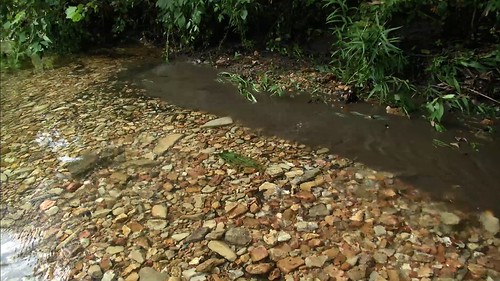
An example of the damage feral swine can have on water quality.
How does the old saying go? That’s right, “Happier than a pig in mud!” Feral swine are no exception to this old farmer’s anecdote. Because they lack sweat glands, wallowing in mud and water is an instinctual behavior necessary for them to maintain a healthy body temperature. Unfortunately this behavior has cascading impacts, not only to water quality in individual streams, ponds, and wetlands, but to entire watersheds and ecosystems.
Excessive feral swine traffic around wallows and water sources causes erosion along stream banks and shorelines. Sounders, or family groups, of feral swine spend large amounts of their day around the wallow, especially in hot weather, which means they leave significant amounts of urine and feces in and around the water. The impacts to water quality go far beyond the immediate wallow site when silt, excrement, and potentially harmful pathogens, are washed down stream.
Water polluted from feral swine wallowing can be contaminated with parasites and bacteria such as giardia, salmonella, and pathogenic E. coli that could be transmitted to humans and other animals. This can happen when feral swine use an agricultural water source, such as an irrigation pond, or if feral swine are active in an area people use for recreation. Contamination can even occur if feral swine use a site upstream in the watershed and rain runoff carries contaminates downstream. In many watersheds, feral swine damage to water quality, wetlands, and riparian habitats also threatens native wildlife, including threatened and endangered species, which depend on these ecosystems.
The pathogens transmitted by feral swine can sicken livestock, pets, and people. Livestock and pets may become ill by drinking water from streams or ponds contaminated by feral swine. Humans are at risk when swimming or wading in contaminated water, from eating crops in which feral swine have rooted or defecated, or if feral swine have contaminated the irrigation source for the crops. Feral swine are suspected to have played a role in the contamination of surface water and spinach fields in California, causing a food-borne illness outbreak which sickened 205 people and resulted in three deaths.
No matter the water source, feral swine will muddy it. The U.S. Department of Agriculture’s Animal and Plant Health Inspection Service (APHIS) National Feral Swine Damage Management Program has been appropriated $20 million annually to address the management of damage caused by invasive feral swine. The program’s overall goal in the United States and its territories, is to protect agriculture, natural resources, property, animal health, and human health and safety by managing damage caused by feral swine and, where possible, reducing or eliminating feral swine populations. The program works in cooperation with states, tribes, and other federal and international agencies, universities, and other stakeholders to achieve management goals. Visit our website for more information.
For an interactive look at USDA’s work to ensure your food is safe, visit the USDA Results project on Medium.com and read Chapter Seven: Safer Food and Greater Consumer Confidence.
No comments:
Post a Comment
Note: Only a member of this blog may post a comment.